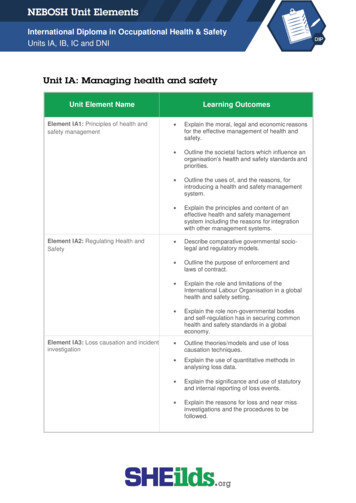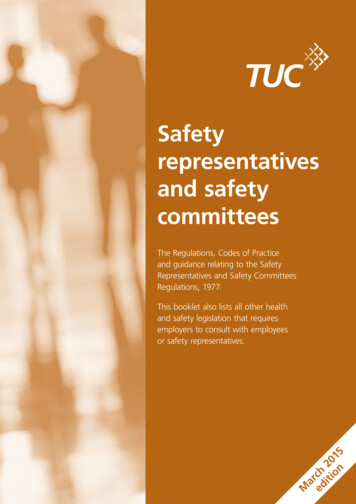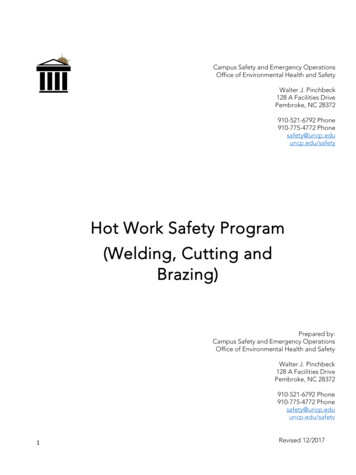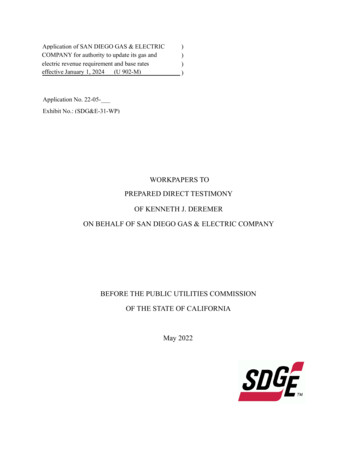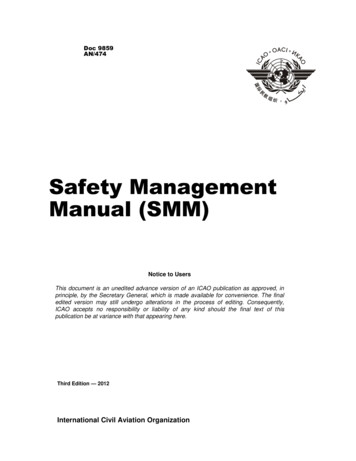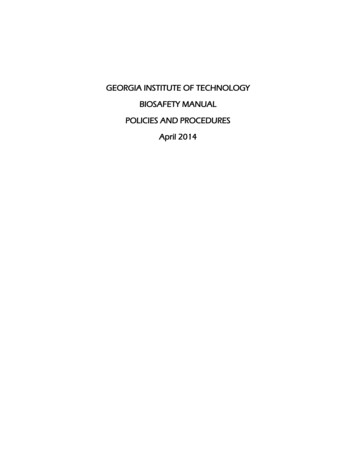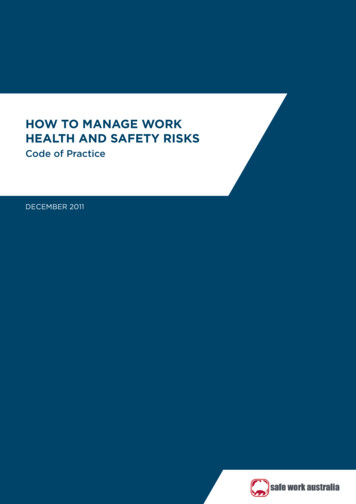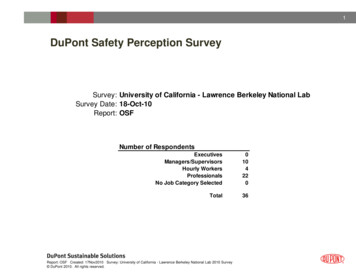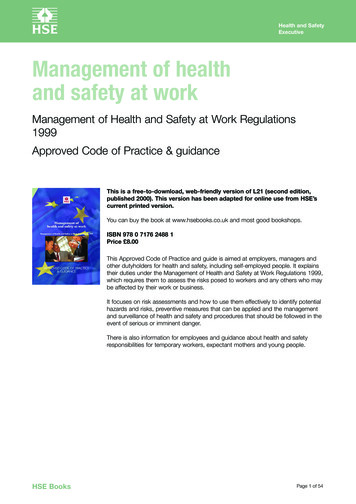
Transcription
Health and SafetyExecutiveManagement of healthand safety at workManagement of Health and Safety at Work Regulations1999Approved Code of Practice & guidanceThis is a free-to-download, web-friendly version of L21 (second edition,published 2000). This version has been adapted for online use from HSE’scurrent printed version.You can buy the book at www.hsebooks.co.uk and most good bookshops.ISBN 978 0 7176 2488 1Price 8.00This Approved Code of Practice and guide is aimed at employers, managers andother dutyholders for health and safety, including self-employed people. It explainstheir duties under the Management of Health and Safety at Work Regulations 1999,which requires them to assess the risks posed to workers and any others who maybe affected by their work or business.It focuses on risk assessments and how to use them effectively to identify potentialhazards and risks, preventive measures that can be applied and the managementand surveillance of health and safety and procedures that should be followed in theevent of serious or imminent danger.There is also information for employees and guidance about health and safetyresponsibilities for temporary workers, expectant mothers and young people.HSE BooksPage 1 of 54
Health and SafetyExecutive Crown copyright 2000First published 1992Second Edition 2000Reprinted 2000, 2001 (twice), 2002, 2004, 2005, 2007ISBN 978 0 7176 2488 1All rights reserved. No part of this publication may be reproduced, stored ina retrieval system, or transmitted in any form or by any means (electronic,mechanical, photocopying, recording or otherwise) without the prior writtenpermission of the copyright owner.Applications for reproduction should be made in writing to:The Office of Public Sector Information, Information Policy Team,Kew, Richmond, Surrey TW9 4DU or e-mail: licensing@opsi.gov.ukApproved Code of Practice and guidanceThis Code has been approved by the Health and Safety Commission, with theconsent of the Secretary of State. It gives practical advice on how to comply withthe law. If you follow the advice you will be doing enough to comply with the lawin respect of those specific matters on which the Code gives advice. You may usealternative methods to those set out in the Code in order to comply with the law.However, the Code has special legal status. If you are prosecuted for breach ofhealth and safety law, and it is proved that you did not follow the relevant provisionsof the Code, you will need to show that you have complied with the law in someother way or a court will find you at fault.This document also includes other, more general guidance not having this specialstatus. This guidance is issued by the Health and Safety Commission. Followingthe guidance is not compulsory and you are free to take other action. But if youdo follow the guidance you will normally be doing enough to comply with the law.Health and safety inspectors seek to secure compliance with the law and may referto this guidance as illustrating good practice.The Management of Health and Safety at Work Regulations are regularly subjectto revision and amendment. You should check you have a copy of the most up-todate statutory instrument of these regulations when applying them.Page 2 of 54
Health and SafetyExecutiveContentsEditorial note 5Foreword 6Introduction7Regulation 1Citation, commencement and interpretation 9Regulation 2Disapplication of these Regulations 10Regulation 3Risk assessment 10General principles and purpose of risk assessment 11Suitable and sufficient 12Risk assessment in practice 13Identifying the hazards 15Identifying who might be harmed and how 15Evaluating the risks from the identified hazards 15Recording 15Review and revision 16Assessment under other regulations 16Regulation 4Principles of prevention to be applied 17Regulation 5Health and safety arrangements 18Planning 18Organisation 19Control 19Monitoring 19Review 20Regulation 6Health surveillance 20Regulation 7Health and safety assistance 21Regulation 8Procedures for serious and imminent danger andfor danger areas 24Regulation 9Contacts with external services 24Danger areas 26Contacts with external services 26Regulation 10 Information for employees 26Regulation 11 Co-operation and co-ordination 28Appointment of health and safety co-ordinator 29Person in control 29Regulation 12 Persons working in host employers’ orself-employed persons’ undertakings 30Regulation 13 Capabilities and training 31Regulation 14 Employees’ duties 33Management of health and safety at workPage 3 of 54
Health and SafetyExecutiveRegulation 15 Temporary workers 34Fixed-duration contracts 34Employment businesses 34Self-employed 35Regulation 16 Risk assessment in respect of new or expectant mothers 35Regulation 17 Certificate from a registered medical practitioner in respect ofnew or expectant mothers 36Regulation 18 Notification by new or expectant mothers 36Regulation 19 Protection of young persons 37Regulation 20 Exemption certificates 39Regulation 21 Provisions as to liability 39Employers’ liability 39Regulation 22 Exclusion of civil liability 40Regulation 23 Extension outside Great Britain 40Regulation 24 Amendment of the Health and Safety (First-Aid) Regulations1981 40Regulation 25 Amendment of the Offshore Installations and Pipeline Works(First-Aid) Regulations 1989 41Regulation 26 Amendment of the Mines Miscellaneous Health and SafetyProvisions Regulations 1995 41Regulation 27 Amendment of the Construction (Health, Safety andWelfare) Regulations 1996 42Regulation 28 Regulations to have effect as health and safetyregulations 42Regulation 29 Revocations and consequential amendments 43Regulation 30 Transitional provision 43Schedule 1General principles of prevention 44Schedule 2Consequential amendments 45References and further reading 51Select index 53Further information 54Management of health and safety at workPage 4 of 54
Health and SafetyExecutiveEditorial noteSince this Approved Code of Practice and Guidance was written, regulation 22has been amended by the Management of Health and Safety at Work and FirePrecautions (Workplace) (Amendment) Regulations 2003. This amendment cameinto force from 27th October 2003.Regulation 22 now reads:Restriction of civil liability for breach of statutory dutyBreach of a duty imposed on an employer by these Regulations shall not confer aright of action in any civil proceedings insofar as that duty applies for the protectionof persons not in his employment.The amendment to Regulation 22 also alters other Regulations in this ApprovedCode of Practice and Guidance, as follows:For Regulation 2 there shall be substituted the following regulation:Disapplication of these Regulations(1) These Regulations shall not apply to or in relation to the master orcrew of a ship, or to the employer of such persons, in respect of the normal shipboard activities of a ship’s crew which are carried out solely by the crew under thedirection of the master.(2) Regulations 3 (4), (5), 10(2) and 19 shall not apply to occasional workor short-term work involving work regarded as not being harmful, damaging ordangerous to young people in a family undertaking.(3)In this regulation –“normal ship-board activities” include –(a)(b)the construction, reconstruction on conversion of a ship outside, but notinside, Great Britain; andthe repair of a ship save repair when carried out in dry dock; “ship”includes every description of vessel used in navigation, other than a shipbelonging to Her Majesty which forms part of Her Majesty’s Navy”.In Regulation 3 (3) the words “and where” to the end shall follow and not appear insubparagraph (b).Regulation 19 (4) shall be omitted.Management of health and safety at workPage 5 of 54
Health and SafetyExecutiveForewordThis document contains advice on how to comply with duties under theManagement of Health and Safety at Work Regulations 1999. It contains theregulations themselves, an Approved Code of Practice (ACOP) which givesadvice that has a special legal status described on page ii on preferred means ofcompliance, and more general guidance that does not have this special statuson ways to comply with the law. The regulations are shown in italics, the ACOP isbold type, and the guidance is in plain type. The status of the ACOP and guidancematerial is described on page ii.The Management of Health and Safety at Work Regulations 1999 revoke andreplace the 1992 Regulations of the same title. This ACOP replaces that associatedwith the 1992 Regulations.Notice of ApprovalBy virtue of Section 16(4) of the Health and Safety at Work etc Act 1974, andwith the consent of the Secretary of State for the Environment, Transport and theRegions, the Health and Safety Commission has on 9 December 1999 approvedthe Code of Practice entitled Management of Health and Safety at Work.The Code of Practice is approved for the purposes of providing practical guidancewith respect to the requirements of the Management of Health and Safety at WorkRegulations 1999. The Code of Practice comes into effect on 29 December 1999.SignedROSEMARY BANNERSecretary of Health and Safety Commission16 December 1999The Health and Safety Commission (HSC) and the Health and Safety Executive(HSE) merged on 1 April 2008 to form a single national regulatory body. From thatdate, the Health and Safety Executive became responsible for approving Codes ofPractice, with the consent of the Secretary of State.Management of health and safety at workPage 6 of 54
Health and SafetyExecutiveIntroductionIntroduction1The original Management of Health and Safety at Work Regulations (‘theManagement Regulations’) came into force in 19931 as the principal method ofimplementing the EC Framework Directive (89/391/EEC), adopted in 1989. TheRegulations were supported by an Approved Code of Practice. The originalRegulations have had to be amended four times since 1992 by the Management ofHealth and Safety at Work (Amendment) Regulations 1994,2 which relates to new orexpectant mothers, the Health and Safety (Young Persons) Regulations 1997,3 theFire Precautions (Workplace) Regulations 19974 and by the Management of Healthand Safety at Work Regulations 1999.5 Because the original Regulations have beenso significantly amended, they have been revised and published with this newApproved Code of Practice.2The Fire Precautions (Workplace) Regulations 1997, as amended by the FirePrecautions (Workplace) (Amendment) Regulations 19996 (‘the Fire Regulations’),introduced by the Home Office, amend the Management Regulations in severalrespects. The amendments made by the Fire Regulations make explicit the riskassessment requirement, in so far as it relates to fire safety. They directly requireemployers to take account of their general fire precautions requirements in Part II ofthe Fire Regulations (concerning fire-fighting, fire detection, emergency routes andexits and their maintenance) in their assessments. The amendments made by theFire Regulations affect employers but not self-employed people who do not employothers. The Fire Regulations also introduce:(a)(b)(c)a requirement for competent assistance to deal with general fire safety risks;a requirement to provide employees with information on fire provisions; anda requirement on employers and self-employed people in a shared workplaceto co-operate and co-ordinate with others on fire provisions and to provideoutside employers with comprehensive information on fire provisions.See References and Further reading section. Further guidance on fire precautions isavailable in Fire safety: An employer’s guide.3The duties of the Management Regulations overlap with other regulationsbecause of their wide-ranging general nature. Where duties overlap, compliancewith the more specific regulation will normally be sufficient to comply with thecorresponding duty in the Management Regulations. For example, the Controlof Substances Hazardous to Health Regulations (COSHH) require employers andthe self-employed to assess the risks from exposure to substances hazardousto health. An assessment made for the purposes of COSHH will not need to berepeated for the purposes of the Management Regulations. Other instances whereoverlap may occur include the appointment of people to carry out specific tasksor arrangements for emergencies. However, where the duties in the ManagementRegulations go beyond those in the more specific regulations, additional measureswill be needed to comply fully with the Management of Health and Safety at WorkRegulations.S.I. 1992/2051S.I. 1994/28653S.I. 1997/1354S.I. 1997/18405The Management of Health and Safety at Work Regulations 1999 introduced amendmentsproposed by the Health and Safety (Miscellaneous Modification) Regulations 1999.6S.I. 1999/187712GuidanceManagement of health and safety at workPage 7 of 54
Health and SafetyExecutiveIntroduction4Although only the courts can give an authoritative interpretation of law, inconsidering the application of these regulations and guidance to people workingunder another’s direction, the following should be considered.5If people working under the control and direction of others are treated asself-employed for tax and national insurance purposes they may nevertheless betreated as their employees for health and safety purposes. It may therefore benecessary to take appropriate action to protect them. If any doubt exists aboutwho is responsible for the health and safety of a worker this could be clarified andincluded in the terms of a contract. However, remember, a legal duty under section3 of the Health and Safety at Work etc Act 1974 (HSW Act)7 cannot be passed onby means of a contract and there will still be duties towards others under section 3of HSW Act. If such workers are employed on the basis that they are responsiblefor their own health and safety, legal advice should be sought before doing so.6Words or expressions which are defined in the Management Regulations orin the HSW Act have the same meaning in this Code unless the context requiresotherwise.Guidance7S.I. 1974 c.37Management of health and safety at workPage 8 of 54
Health and SafetyExecutiveRegulationRegulation 1 Citation, commencement andinterpretation(1) These Regulations may be cited as the Management of Health andSafety at Work Regulations 1999 and shall come into force on 29th December1999.(2)In these Regulations-“ the 1996 Act” means the Employment Rights Act 1996(a);“the assessment” means, in the case of an employer or self-employed person, theassessment made or changed by him in accordance with regulation 3;“child” (a)(b)as respects England and Wales, means a person who is not overcompulsory school age, construed in accordance with section 8 of theEducation Act 1996(b); andas respects Scotland, means a person who is not over school age,construed in accordance with section 31 of the Education (Scotland) Act1980(c);“employment business” means a business (whether or not carried on with a view toprofit and whether or not carried on in conjunction with any other business) whichsupplies persons (other than seafarers) who are employed in it to work for andunder the control of other persons in any capacity;“ fixed-term contract of employment” means a contract of employment for aspecific term which is fixed in advance or which can be ascertained in advance byreference to some relevant circumstance;“ given birth” means delivered a living child or, after twenty-four weeks ofpregnancy, a stillborn child;“ new or expectant mother” means an employee who is pregnant; who has givenbirth within the previous six months; or who is breastfeeding;“ the preventive and protective measures” means the measures which have beenidentified by the employer or by the self-employed person in consequence of theassessment as the measures he needs to take to comply with the requirementsand prohibitions imposed upon him by or under the relevant statutory provisionsand by Part II of the Fire Precautions (Workplace) Regulations 1997(d);“ young person” means any person who has not attained the age of eighteen.(3)Any reference in these Regulations to-(a)a numbered regulation or Schedule is a reference to the regulation orSchedule in these Regulations so numbered; ora numbered paragraph is a reference to the paragraph so numbered inthe regulation in which the reference appears.(b)(a)(b)(c)1(d)1996 c.18.1996 c.56.1980 c.44.S.I. 1997/1840; amended by S.I. 1999/1877Management of health and safety at workPage 9 of 54
Health and SafetyExecutiveRegulationRegulation 2 Disapplication of these Regulations(1) These Regulations shall not apply to or in relation to the master or crewof a sea-going ship or to the employer of such persons in respect of the normalship-board activities of a ship’s crew under the direction of the master.(2) Regulations 3(4), (5), 10(2) and 19 shall not apply to occasional work orshort-term work involving(a)(b)2Guidancedomestic service in a private household; orwork regulated as not being harmful, damaging or dangerous to youngpeople in a family undertaking.7Regulation 2(1) excludes the master and crew of a sea-going ship, as similarduties are placed on them by the Merchant Shipping and Fishing Vessels (Healthand Safety at Work) Regulations 1997.8 However, when a ship is in a port inGreat Britain and shoreside workers and the ship’s crew work together, eg in dockoperations, or in carrying out repairs to the ship, these Regulations may apply.Dock operations, ship construction, ship repair carried out in port with shoresideassistance, and work connected to construction or the offshore industry (otherthan navigation, pollution prevention and other aspects of the operation of theship, which are subject to international shipping standards) are not considered as‘normal ship-board activities’ and are therefore subject to these Regulations.8Regulation 2(2) clarifies that these Regulations do not apply to domesticservices in a private household.2Regulation8S.I. 1997/2962Regulation 3 Risk assessment(1)Every employer shall make a suitable and sufficient assessment of-(a)the risks to the health and safety of his employees to which they areexposed whilst they are at work; andthe risks to the health and safety of persons not in his employmentarising out of or in connection with the conduct by him of hisundertaking,(b)for the purpose of identifying the measures he needs to take to comply with therequirements and prohibitions imposed upon him by or under the relevant statutoryprovisions and by Part II of the Fire Precautions (Workplace) Regulations 1997.(2) Every self-employed person shall make a suitable and sufficientassessment of(a)(b)the risks to his own health and safety to which he is exposed whilst he isat work; andthe risks to the health and safety of persons not in his employmentarising out of or in connection with the conduct by him of hisundertaking,for the purpose of identifying the measures he needs to take to comply with therequirements and prohibitions imposed upon him by or under the relevant statutoryprovisions.3(3) Any assessment such as is referred to in paragraph (1) or (2) shall bereviewed by the employer or self-employed person who made it if-Management of health and safety at workPage 10 of 54
Health and SafetyExecutive(a)(b)Regulationthere is reason to suspect that it is no longer valid; orthere has been a significant change in the matters to which it relates;and where as a result of any such review changes to an assessment arerequired, the employer or self-employed person concerned shall makethem.(4) An employer shall not employ a young person unless he has, inrelation to risks to the health and safety of young persons, made or reviewed anassessment in accordance with paragraphs (1) and (5).(5) In making or reviewing the assessment, an employer who employs or isto employ a young person shall take particular account of(a)(b)(c)(d)(e)(f)(g)the inexperience, lack of awareness of risks and immaturity of youngpersons;the fitting-out and layout of the workplace and the workstation;the nature, degree and duration of exposure to physical, biological andchemical agents;the form, range, and use of work equipment and the way in which it ishandled;the organisation of processes and activities;the extent of the health and safety training provided or to be provided toyoung persons; andrisks from agents, processes and work listed in the Annex to CouncilDirective 94/33/EC(a) on the protection of young people at work.(6)Where the employer employs five or more employees, he shall record-(a)(b)the significant findings of the assessment; andany group of his employees identified by it as being especially at risk.3(a)ACOPGeneral principles and purpose of risk assessmentOJ No. L216, 20.8.94, p.12.9This regulation requires all employers and self-employed people toassess the risks to workers and any others who may be affected by theirwork or business. This will enable them to identify the measures they needto take to comply with health and safety law. All employers should carry outa systematic general examination of the effect of their undertaking, their workactivities and the condition of the premises. Those who employ five or moreemployees should record the significant findings of that risk assessment.10 A risk assessment is carried out to identify the risks to health and safetyto any person arising out of, or in connection with, work or the conduct oftheir undertaking. It should identify how the risks arise and how they impacton those affected. This information is needed to make decisions on how tomanage those risks so that the decisions are made in an informed, rationaland structured manner, and the action taken is proportionate.311 A risk assessment should usually involve identifying the hazardspresent in any working environment or arising out of commercial activitiesand work activities, and evaluating the extent of the risks involved, takinginto account existing precautions and their effectiveness. In this ApprovedCode of Practice:Management of health and safety at workPage 11 of 54
Health and SafetyExecutiveACOP(a)a hazard is something with the potential to cause harm (this can includearticles, substances, plant or machines, methods of work, the workingenvironment and other aspects of work organisation);a risk is the likelihood of potential harm from that hazard being realised.The extent of the risk will depend on:(b)(i)(ii)the likelihood of that harm occurring;the potential severity of that harm, ie of any resultant injury oradverse health effect; and(iii) the population which might be affected by the hazard, ie thenumber of people who might be exposed.12 The purpose of the risk assessment is to help the employer or selfemployed person to determine what measures should be taken to complywith the employer’s or self-employed person’s duties under the ‘relevantstatutory provisions’ and Part II of the Fire Regulations. This covers thegeneral duties in the HSW Act and the requirements of Part II of the FireRegulations and the more specific duties in the various acts and regulations(including these Regulations) associated with the HSW Act. Once themeasures have been determined in this way, the duty to put them into effectwill be defined in the statutory provisions. For example a risk assessment onmachinery would be undertaken under these Regulations, but the Provisionand Use of Work Equipment Regulations (PUWER 1998)9 determine whatprecautions must be carried out. A risk assessment carried out by a selfemployed person in circumstances where he or she does not employ othersdoes not have to take into account duties arising under Part II of the FireRegulations.Suitable and sufficient13 A suitable and sufficient risk assessment should be made. ‘Suitableand sufficient’ is not defined in the Regulations. In practice it means the riskassessment should do the following:(a)The risk assessment should identify the risks arising from or inconnection with work. The level of detail in a risk assessmentshould be proportionate to the risk. Once the risks are assessedand taken into account, insignificant risks can usually be ignored,as can risks arising from routine activities associated with life ingeneral, unless the work activity compounds or significantly altersthose risks. The level of risk arising from the work activity shoulddetermine the degree of sophistication of the risk assessment.(i)(ii)39For small businesses presenting few or simple hazards a suitableand sufficient risk assessment can be a very straightforwardprocess based on informed judgement and reference to appropriateguidance. Where the hazards and risks are obvious, they can beaddressed directly. No complicated processes or skills will berequired.In many intermediate cases the risk assessment will need to bemore sophisticated. There may be some areas of the assessmentfor which specialist advice is required; for example risks whichrequire specialist knowledge such as a particularly complex processor technique, or risks which need specialist analytical techniquessuch as being able to measure air quality and to assess its impact.S.I. 1998/2306Management of health and safety at workPage 12 of 54
Health and SafetyExecutiveWhenever specialist advisers are used, employers should ensurethat the advisers have sufficient understanding of the particularwork activity they are advising on, this will often require effectiveinvolvement of everyone concerned - employer, employees andspecialist.(iii) Large and hazardous sites will require the most developed andsophisticated risk assessments, particularly where there arecomplex or novel processes. In the case of certain manufacturingsites who use or store bulk hazardous substances, large scalemineral extraction or nuclear plant, the risk assessment will bea significant part of the safety case or report which is legallyrequired and may incorporate such techniques as quantified riskassessment. A number of other statutory requirements exist (egthe Control of Major Accident Hazards (COMAH), and NuclearInstallations licensing arrangements) which include more specificand detailed arrangements for risk assessment.(iv) Risk assessments must also consider all those who might beaffected by the undertaking, whether they are workers or otherssuch as members of the public. For example, the risk assessmentproduced by a railway company will inter alia, have to consider thehazards and risks which arise from the operation and maintenanceof rail vehicles and train services and which might adversely affectworkers (their own employees and others), passengers and anymember of the public who could foreseeably be affected (eg levelcrossing users).ACOP(b)(c)Employers and the self-employed are expected to take reasonable stepsto help themselves identify risks, eg by looking at appropriate sources ofinformation, such as relevant legislation, appropriate guidance, suppliermanuals and manufacturers’ instructions and reading trade press, orseeking advice from competent sources. They should also look at anduse relevant examples of good practice from within their industry. Therisk assessment should include only what an employer or self-employedperson could reasonably be expected to know; they would not beexpected to anticipate risks that were not foreseeable;The risk assessment should be appropriate to the nature of the workand should identify the period of time for which it is likely to remainvalid. This will enable management to recognise when short-termcontrol measures need to be reviewed and modified, and to put in placemedium and long-term controls where these are necessary.14 For activities where the nature of the work may change fairly frequentlyor the workplace itself changes and develops (such as a construction site),or where workers move from site to site, the risk assessment might have toconcentrate more on the broad range of risks that can be foreseen. Whenother less common risks arise, detailed planning and employee training willbe needed to take account of those risks and enable them to be controlled.Risk assessment in practice315 There are no fixed rules about how a risk assessment should be carriedout; indeed it will depend on the nature of the work or business and thetypes of hazards and risks. Paragraph 18 does, however, set out the generalprinciples that should be followed. The risk assessment process needs tobe practical and take account of the views of employees and their safetyrepresentatives who will have practical knowledge to contribute. It shouldinvolve management, whether or not advisers or consultants assist withthe detail. Employers should ensure that those involved take all reasonableManagement of health and safety at workPage 13 of 54
Health and SafetyExecutiveACOPcare in carrying out the risk assessment. For further guidance see HSE’spublication Five steps to risk assessment (see References and further readingsection).16 Where employees of different employers work in the same workplace,their respective employers may have to co-operate to produce an overall riskassessment. Detailed requirements on co-operation and co-ordination arecovered by Regulation 11.17 In some cases employers may make a first rough assessment, toeliminate from consideration those risks on which no further action isneeded. This should also show where a fuller assessment is needed, ifappropriate, using more sophisticated techniques. Employers who controla number of similar workplaces containing similar activities may producea ‘model’ risk assessment reflecting the core hazards and risks associatedwith these activities. ‘Model’ assessments may also be developed by tradeassociations, employers’ bodies or other organisations concerned with aparticular activity. Such ‘model’ assessments may be applied by employersor managers at each workplace, but only if they:(a)(b)satisfy themselves that the ‘model’ assessment is appropriate to theirtype of work; andadapt the ‘model’ to the detail of their ow
Management of health and safety at work Page 4 of 54 Health and Safety Executive Regulation 15 Temporary workers 34 Fixed-duration contracts 34 Employment businesses 34 Self-employed 35 Regulation 16 Risk assessment in respect of new or expectant mothers 35 Regulation 17 Certificate from a registered medical practitioner in respect of new or expectant mothers 36

